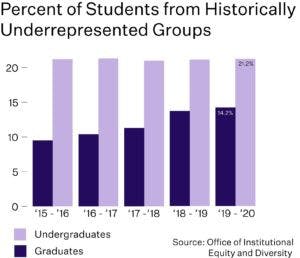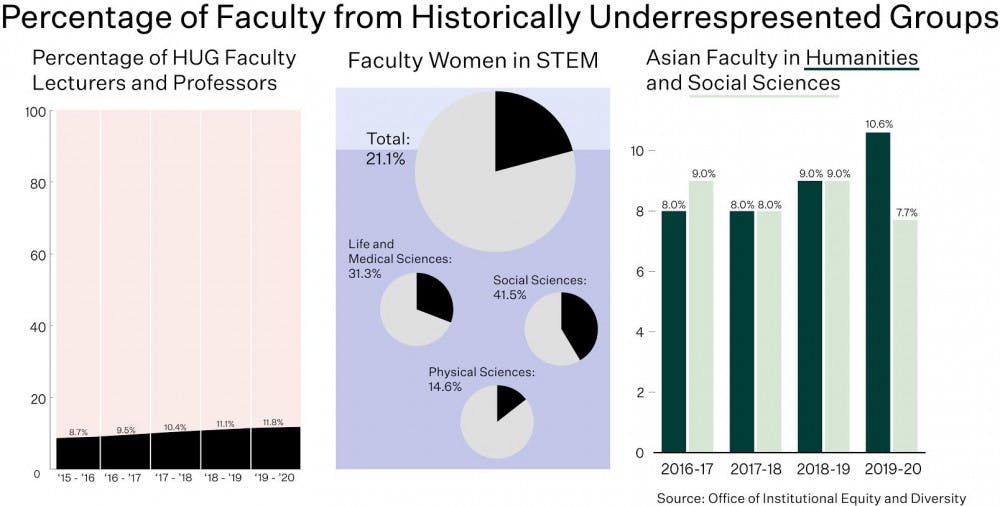The Office of Institutional Equity and Diversity released its fourth annual progress report for “Pathways to Diversity and Inclusion: An Action Plan for Brown University” May 19. Through data gathered from the 2018-2019 academic year, the 2020 DIAP report highlighted a steady rise in the recruitment of faculty and graduate students from historically underrepresented groups, while HUG representation among undergraduate students remains stagnant.
The DIAP was created in February 2016 to focus on the recognition, recruitment and retention of HUGs. By focusing on these factors, the DIAP seeks to improve diversity and inclusion efforts at the University, according to the report. HUGs are defined as those who self-identify as “American Indian, Alaskan Native, African American, Hispanic or Latinx and Native Hawaiian and/or Pacific Islander.”
“The Annual Report of the DIAP is meant to provide an overview of our progress of the prior academic year,” wrote Vice President for Institutional Equity and Diversity Shontay Delalue in an email to The Herald.
DIAP advancements fall into six “priority areas”: Investing in People, Academic Excellence, Curriculum, Community, Knowledge and Accountability. The 2020 DIAP includes results from a second campus climate survey, following an original series of campus climate surveys released in 2016, to continue addressing “experiences of bias, perceived progress toward the goals of the DIAP and the climate for students, faculty and staff.”
To further the University’s progress in fostering a more inclusive environment, the OIED will continue to assess the survey’s data in the coming year. “The 2020 DIAP Annual Report, in particular, is abbreviated given we are currently focused on assessing whether and how we met the original goals delineated in the DIAP at the University and departmental levels," Delalue wrote.
The campus climate survey “serves as a mechanism for the University to measure the long-term impacts of the DIAP on issues related to campus climate as well as the perception of progress toward DIAP goals on campus,” Delalue wrote. “The survey also provides data about the experiences of faculty, students and staff, which allows us to see both positive and negative trends that inform new approaches to meeting the goals of the DIAP.”
The 2020 DIAP also outlined progress for the Presidential Diversity Postdoctoral Fellowship, a program for PhD graduates from underrepresented groups which has hosted 28 scholars spread across five cohorts since 2015. Now, 79 percent of former fellows hold faculty positions throughout the U.S. and 32 percent hold faculty positions at the University. The report additionally shows an increase in designated DIAP courses, growing from 186 the previous year to 211. Other accomplishments include undergraduate students who receive full financial aid also receiving support for required course materials and 60 University student-athletes working directly in Providence neighborhoods to develop athletic programs for local youth.
Alongside notable successes reflected in the DIAP report, Delalue noted areas for improvement. Since the original DIAP was released in 2016, the report has demonstrated a need for the increase of female faculty in the physical sciences. Additionally, recent data from the campus climate survey illustrates higher proportions of biased encounters for underrepresented racial and gender identities. In partnership with several departments throughout campus, the OIED plans to use the data to improve in these areas.
“The most significant takeaway (of the DIAP) continues to be the number of people in our campus community who are committed to keeping this work at the front and center,” Delalue wrote.
HUG representation among faculty and staff
According to Delalue, in the academic year before the DIAP’s release, 58 faculty members self-identified as belonging to a HUG. During the 2018-2019 academic year, as reflected in the 2020 DIAP report, this number increased to 86 faculty who are members of HUGs.
Among new faculty hired during the 2018-2019 academic year, 11 out of 31 domestic faculty members whose race is known self-identified as members of HUGs, amounting to 35.5 percent. Across all faculty during the 2018-2019 academic year, 86 out of 772 self-identified as members of HUGs, for a total of 11.1 percent. When the DIAP was released in 2016, only 71 out of 749 (9.5 percent) faculty members self-identified as members of HUGs.
Delalue noted that to double the number of faculty from HUGs in 2016 by 2022 — an established goal of the original DIAP in 2016 — the OIED has partnered with the Office of the Provost and the Office of the Dean of the Faculty, among others. This collaboration aims to recruit faculty from HUGs through cluster hiring, which involves hiring faculty with similar focus areas from various disciplines, and postdoctoral scholar programs. To support HUG faculty retention, the OIED provides several professional development workshops, mentoring programs and networks.
“We expect that ongoing efforts and initiatives across the University to hire and retain HUG faculty will allow us to meet or come close to meeting the goal stated in the DIAP,” Delalue wrote.
During fall 2018, 17.1 percent of staff members self-identified as members of HUGs, an increase from 15.3 percent of staff members when the DIAP was first released.
HUG representation in the undergraduate and graduate student bodies
According to Delalue, in the 2014-2015 academic year before the DIAP’s 2016 release, 1,304 out of 6,264 undergraduate students self-identified as members of HUGs. In the 2020 DIAP report, during the 2018-2019 academic year, 1,424 out of 6,752 undergraduate students self-identified that they were members of HUGs, amounting to 21.1 percent of undergraduates.

“In the years ahead, we can look to the work and strategies the (Admission) Office will be considering in focusing on specific groups within the HUG designation to ensure growth in all areas,” Delalue wrote.
Impact of COVID-19 on the DIAP
“As a result of COVID-19, the primary focus of the University in March 2020 was to transition to remote instruction, arrange telecommuting operations for most employees and reduce density on campus to promote the health and safety of the Brown community,” Delalue wrote. Because the global pandemic is ongoing, it is too early to anticipate specific impacts and disruptions to the DIAP and its progress.
Regardless of the University’s forthcoming plans for fall 2020, Delalue emphasized that the OIED will continue supporting the University community and DIAP progress.
“There are some outstanding examples of departments taking this time to focus their programming and other initiatives on how COVID-19 is having (a) disparate impact on historically underrepresented groups and people in vulnerable economic, medical and geographic circumstances. These efforts get at the heart of the DIAP and we will capture them in the 2021 DIAP report,” Delalue concluded.
Approaching fall 2020, the OIED will move to build on the existing plan as it develops Phase II of the DIAP.





